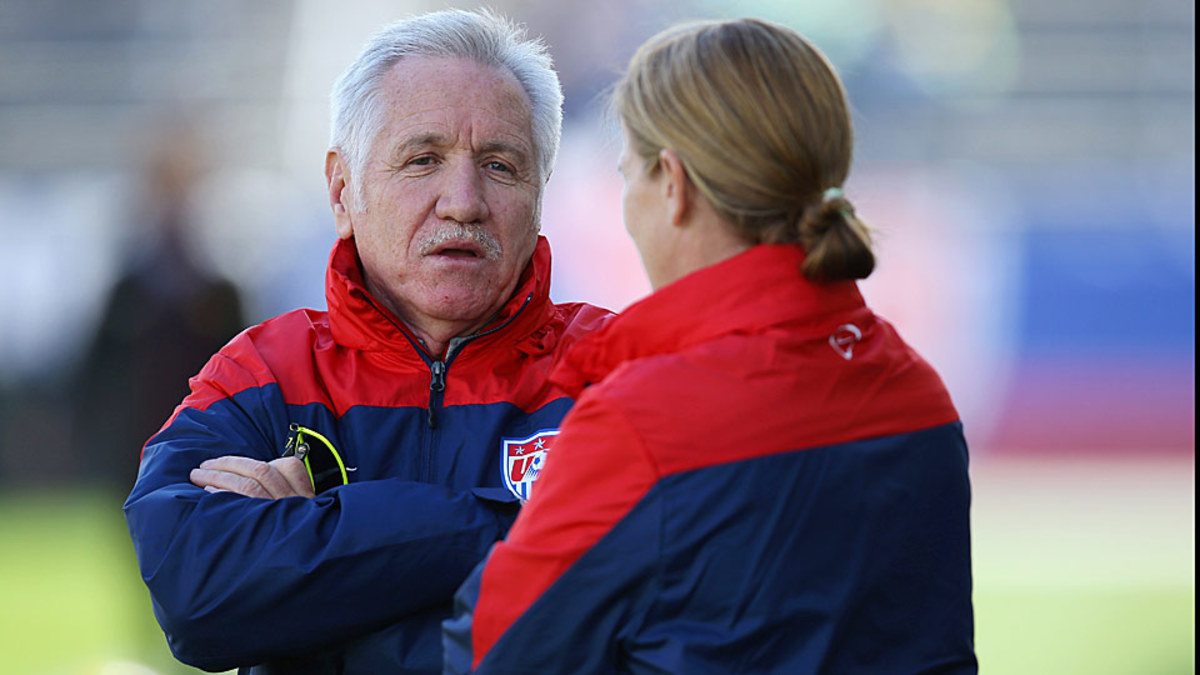
Path to World Cup for former USWNT coach Tom Sermanni unexpected one
Tom Sermanni always expected to be coaching in this Women’s World Cup. He just thought it would be as the U.S. head coach and not as an assistant with the host team, Canada.
But the affable Scot, who was surprisingly fired by U.S. Soccer in April 2014 after just 14 months on the job, sounded relaxed and optimistic in a phone conversation from Vancouver as his Canadian team prepared for Sunday’s Round of 16 game against Switzerland (7:30 p.m. ET, Fox Sports 1).
“I’ve enjoyed coming in here and being able to work with the team and work with [head coach] John Herdman,” said Sermanni, who first started working with Canada last November after being contacted by Herdman, a good friend from their days when Sermanni was coaching Australia and Herdman managed New Zealand.
• Complete 2015 FIFA Women's World Cup bracket
“John is really good at delegating stuff,” said Sermanni. “He has a lot of trust in his staff, so we could be doing different things for different games. I might be given the responsibility of looking at the attacking side of a team or the defensive side or what they do in transition. He really mixes up responsibilities, even things like team meetings.”
Women's World Cup group stage Best XI: Top players from the first round
Sermanni, 60, said the heavy financial support from the Canadian Soccer Association for a long residency in the Vancouver area has given the Canadian team a connection that he has rarely witnessed during his career. And he has been connected to some good teams. Sermanni coached Australia from 2005 to ’12, guiding the Matildas to two straight knockout-round berths. He laid the groundwork that contributed to Australia’s historic 1–0 win over Brazil in the Round of 16 on Sunday.
He started the U.S. job in January 2013, taking over for Pia Sundhage and moving his family to the Los Angeles area, where they still reside (Sermanni has a U.S. green card.) And that year, Sermanni said, he tried to start putting his stamp on the storied U.S. women’s program.
“If I look at the plans, 2013 was an awkward year for the [U.S.] team,” he said. “Because it’s a year where you want to actually use it as a rebuilding year to look at players, to assess players, to give players opportunities because there are no major tournaments that year. We also had more players in Europe than probably ever, and there was the start of a new league [in the NWSL]. That was a year of trying to bring a lot together.”
Sermanni was experimenting into 2014, using younger players at times and not always keeping stars like forward Abby Wambach on the field for the entire 90 minutes. That led to a surprisingly weak performance at the 2014 Algarve Cup, where the U.S. lost 1–0 to Sweden and 5–3 to Denmark. Sermanni was fired in April 2014, a little more than a year before the World Cup, and replaced by Jill Ellis.
The firing blindsided Sermanni, who had never been removed from a coaching job before.
Australia upsets Brazil with win in Women's World Cup knockout round
“I enjoyed the time [as U.S. coach],” he said. “I don’t know in a football sense that I would have done too much differently because I had the idea in my head of planning for the World Cup. I perhaps could have expressed more what I was doing rather than just getting on with the job. I’d been fortunate in Australia where I’d been able to get in and get on with the job I was doing. I had the trust of the federation and people around me that we were going to get to the end part of that job, if that makes sense.
“By the time I left the [U.S.] job, I had a fairly clear idea in the direction of the team, sort of player-wise and tactically," he continued. "But perhaps that wasn’t conveyed enough to people who thought that wasn’t happening. Apart from that, I was comfortable and confident in the job that was going on. I didn’t anticipate what was going to happen.”
When Sermanni was let go, U.S. Soccer president Sunil Gulati cited the Algarve Cup results and what he saw as the general direction of the U.S. team from his own observations and from talking to players and staff. Gulati dismissed suggestions of a player revolt at the time.
• BIRD: USWNT defensively stout but lacking in midfield, attack
In an interview before the World Cup, I asked Wambach about the major decision to change head coaches just a year out from the World Cup. “It wasn’t a light decision that Sunil went through,” Wambach said. “No disrespect to Tom because he’s an amazing guy and had a plan for this team, but I think where we were at wasn’t far enough along for our president. And we had to move forward because we were in a time crunch.
“It wasn’t a group of players that had a coup against Tom,” Wambach continued. “There was enough concern from not just players but staff and from our executives at U.S. Soccer based on results.”
Alex Morgan responds to Colombia star Lady Andrade's trash talk
In some ways, Sermanni represents a path not taken for U.S. Soccer. So I asked him: If you were coaching this U.S. World Cup team, how different would it be in terms of personnel, tactics and style?
“I don’t think there would be a huge change in personnel, to be honest,” Sermanni said. “Like every coach, there would probably be two or three players different because maybe somebody I would have liked a little bit better than another player. I was trying to introduce a slightly different style of football, not make major changes.
“I don’t want to comment on what Jill’s doing because she’s a good friend of mine and a good coach, so it’s not for me to say about style," Sermanni continued. "But what I was trying to introduce was a more balanced style of play, a more possession-oriented style, as well as a high-pressing, intense style of play physically. I wanted us to be able to play a more fluid type of football. That’s evident of the Australia team now, with a fluidity and a tempo and a rhythm about how they play.
“I was trying to bring that into the U.S. team without losing the other parts of the team that made the U.S. strong.”
Familiar Wambach, Morgan USWNT tandem teams together vs. Nigeria
Sermanni said he was starting to do other new things with the U.S. program off the field, including connecting more with the historic players of the team from the 1990s and introducing a program to help older national team players start exploring things they could do once their playing careers were over.
But now he’s enjoying the ride with Canada, with whom he has a contract until the end of this World Cup. After that? Who knows?
“I’ve been fortunate enough to be with a great program in Australia, a great program with the U.S. and now with a great program here [in Canada],” Sermanni said. “So you’re kind of like, ‘What do you want to do next?’ I enjoy living in the U.S., so if opportunities come up in the U.S. I’d certainly like to look at those. But I’ll be honest, since I started coaching I’ve never known what my next direction will be. The road has seemed to sort of fall in front of me.”
It’s still an exciting road for Sermanni, even if he’s not with the Americans.




